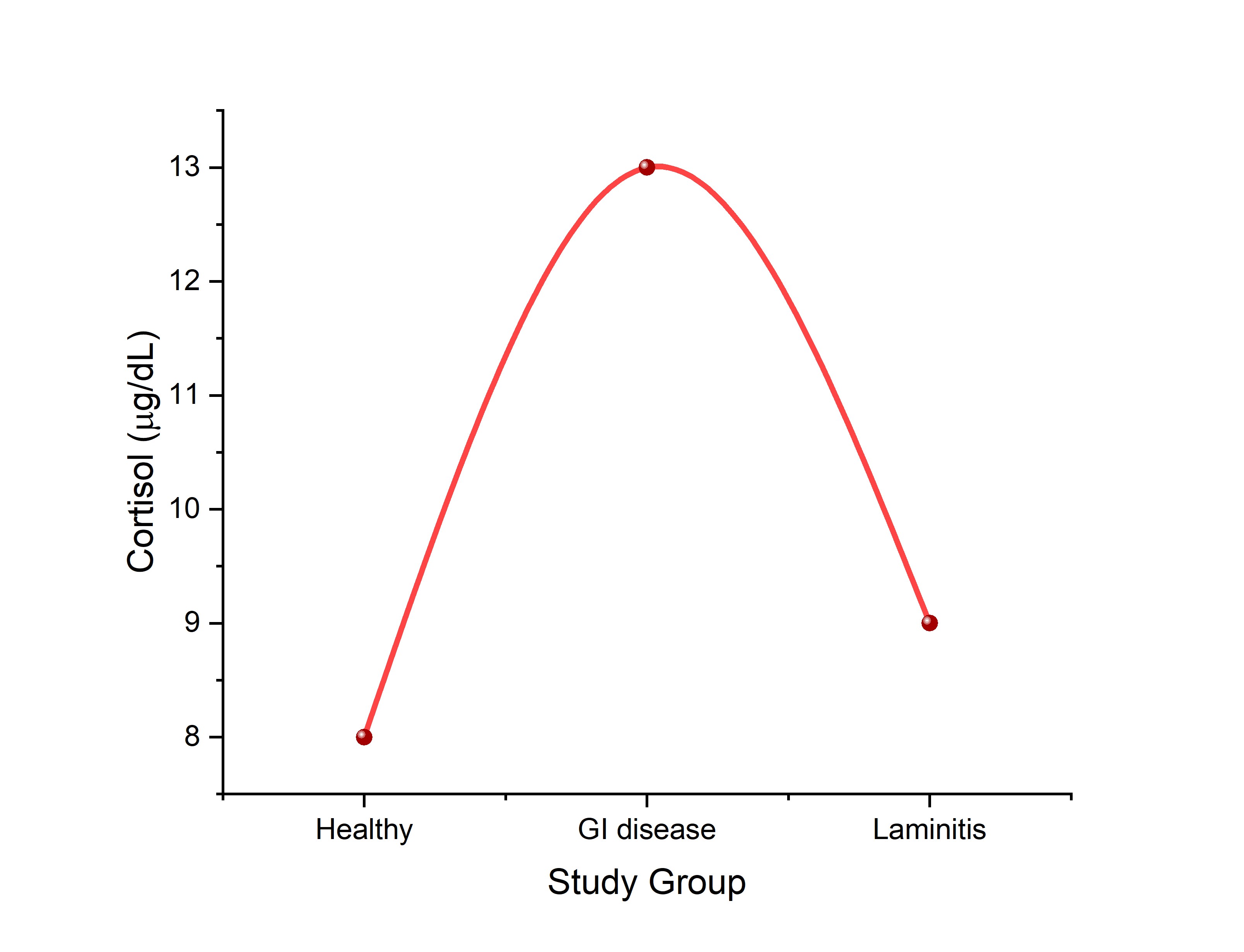An Analysis of Managing Stress Response in Horses to Prevent Laminitis
Abstract
Horses can suffer from the complex and painful condition of Laminitis. Laminitis is caused by various predisposing conditions, although the precise etiology is yet understood. The innate stress response includes substances such as cortisol, histamine, and serum T4 were found to be elevated, which may be the root of the issue or a contributing component. The amount of stress hormones present in Laminitis is largely unknown. To measure stress response variables in laminitic horses while comparing with control horses and horses with Gastrointestinal (GI) disorders. A prospective study was conducted on 40 adult horses brought in for clinical Laminitis, GI anomalies, or non-medical issues. On admission at the hospital, blood was obtained from the horses, and they were sorted into the relevant disease groups (healthy, GI disease, and Laminitis). The levels of serum cortisol, thyroid hormone, plasma histamine, and plasma endogenous adrenocorticotrophic hormone (ACTH) were measured in the samples. Horses with GI disorders and Laminitis have dramatically different levels of stress hormones. Comparing Laminitis to GI illness and control horses, laminitis horses had the highest plasma histamine levels. Compared to horses in good health, animals' Laminitis and gastrointestinal disease showed higher plasma eACTH levels. GI illness in horses had greater serum cortisol levels than in laminitis horses or control horses. Compared to Laminitis and non-laminitis horses, Serum T4 levels were decreased in diseased GI systems in horses. Both plasma histamine and eACTH levels were comparatively higher in laminitis horses. Comparing laminitis horses to healthy horses, serum T4 and cortisol amounts were not significantly different. There must be research to ascertain the impact of stress-related horse sickness caused by hormones.
References
De Laat MA, Reiche DB, Sillence MN, McGree JM. Incidence and risk factors for recurrence of endocrinopathies Laminitis in horses. J Vet Intern Med. 2019;33(3):1473–1482.
Parsons CS, Orsini JA, Krafty R, Capewell L, Boston R. Risk factors for developing acute Laminitis in horses during hospitalization: 73 cases (1997-2004) J Am Vet Med Assoc. 2007;230(6):885–889
Sauer, F.J., Hermann, M., Ramseyer, A., Burger, D., Riemer, S. and Gerber, V., 2019. Effects of breed, management, and personality on cortisol reactivity in sport horses. PLoS One, 14(12), p.e0221794.
Rautschka R, Stanek C, Knezevic PF. Plasma histamine levels in laminitis horses and horses treated with a corticosteroid. Zentralbl Veterinarmed A. 1991;38(9):716–719.
Ayala I, Martos NF, Silvan G, Gutierrez-Panizo C, Clavel JG, Illera JC. Cortisol, adrenocorticotropic hormone, serotonin, adrenaline, and noradrenaline serum concentrations concerning disease and stress in the horse. Res Vet Sci. 2012;93(1):103–107.
Sundra, T., Kelty, E. and Rendle, D., 2023. Preliminary observations on using ertugliflozin in managing hyperinsulinemia and Laminitis in 51 horses: a case series. Equine Veterinary Education, 35(6), pp.311-320.
Wattanapornpilom, T., Pornprasitroj, P., Thongsri, K., Iamprapai, S., Suan-Aoy, P. and Chanda, M., 2022. The Use of Confined Housing in Sand Bedding and Trimming to Manage Phalangeal Rotation and Hoof Malconformation Over 20 weeks in Two Laminitic Stallions. Journal of Equine Veterinary Science, 116, p.104062.
Galinelli, N.C., Bailey, S.R., Bamford, N.J. and Harris, P.A., 2023. Nutritional considerations for the management of equine pituitary pars intermedia dysfunction. Equine Veterinary Education, 35(1), pp.33-44.
Torrent‐Crosa, A., Kamus, L. and O'Grady, S.E., 2023. Clinical application of the wooden shoe to complement surgical management of Laminitis and another foot‐related disease in the horse: A report of three cases. Equine Veterinary Education.
Lynden, J., Hollands, T. and Ogden, J., 2020. A farrier is making every contact count: a micro-level analysis of farrier-client interaction for partnership working in managing a horse with Laminitis—Journal of equine veterinary science, 87, p.102924.
Poochipakorn, C., Sanigavatee, K., Watchrarat, K., Rattanamas, K. and Chanda, M., 2022. Strategic shoeing adjustment is imperative in solving complicated hoof problems while managing distal phalanx rotation in a laminitic horse with sheared heels: Veterinary Record Case Reports, 10(2), p.e286.
Manfredi, J.M., Stapley, E.D., Nadeau, J.A. and Nash, D., 2020. Investigation of the effects of a dietary supplement on insulin and adipokine concentrations in equine metabolic syndrome/insulin dysregulation. Journal of equine veterinary science, 88, p.102930.
Ryan, J., Vinardell, T. and Johnson, J.P., 2020. Supportive care of the hospitalized laminitic horse: a nursing perspective. Veterinary Nursing Journal, 35(7), pp.197-201.
Rahnama, S., Vathsangam, N., Spence, R., Medina-Torres, C.E., Pollitt, C.C., de Laat, M.A., Bailey, S.R. and Sillence, M.N., 2020. Effects of an anti-IGF-1 receptor monoclonal antibody on Laminitis induced by prolonged hyperinsulinemia in Standardbred horses. Plos one, 15(9), p.e0239261.
Paz, C.F.R., Fernandes, T.L.B. and Augusto, L., 2019. Stride kinematic changes in laminitic horses treated with three different types of hoof orthopedic devices Alterações cinemáticas da locomoçāo em cavalos com laminite tratados com três diferentes tipos de órteses para o casco. Semina: Ciências Agrárias, Londrina, 40(6 suplemento 3), pp.3755-3762







